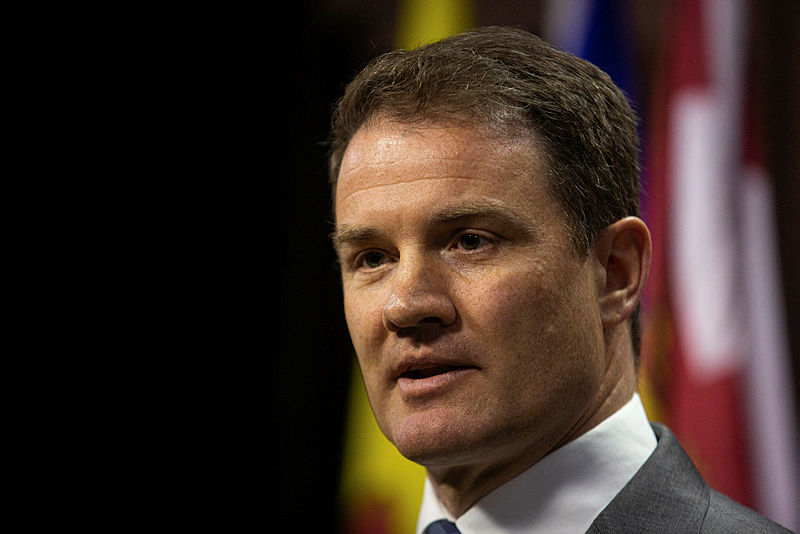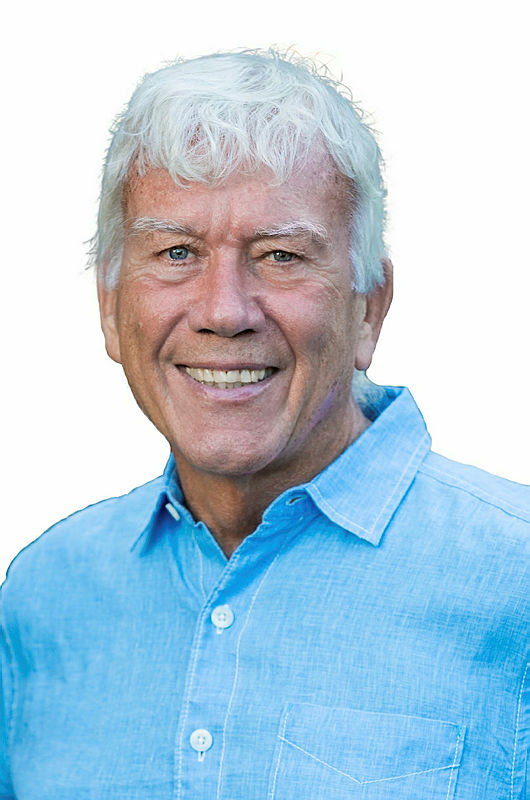Transport Minister Pablo Rodriguez has “opened the door” by establishing an office dedicated to strengthening Canada’s supply chain, but success will depend on understanding that the challenges are broader than the movement of goods, says the president and CEO of Supply Chain Canada.
“Transportation is only one piece of [the] supply chain. Don’t get me wrong. I’m all for the [National Supply Chain] office. This is a great office. They just have to understand that supply chain is greater than just transportation,” said Martin Montanti. “The fruits of that office haven’t come forward yet, but you need to start somewhere.”
Rodriguez (Honoré-Mercier, Que.) announced the launch of the National Supply Chain Office, led by Robert Dick, assistant deputy minister for Transport Canada, on Dec. 1, 2023. Goals of the office include supporting the federal government’s efforts in responding to supply chain disruptions, such as those created by extreme weather events or labour disputes, and to support data sharing so goods can move more efficiently. The office is will also be responsible for developing and implementing a national strategy to support the supply chain.
A national supply chain strategy will require a holistic understanding of what the supply chain is, which is often misunderstood, according to Montanti. Transportation issues are an important part of the supply chain, but an understanding of the end-to-end supply chain requires looking at other issues including contracting and purchasing, as well as warehousing, he said.

“Because [Rodriguez is] the minister of Transportation, I believe his focus is on transportation, [and] how we can improve the transportation in Canada,” said Montanti. “I just think the government has focused too narrowly on transportation, and not enough on the overall supply chain.”
“It’s not what they’re doing is wrong. It’s just that they’re not understanding that they can leverage the other aspects of [the] supply chain at the same time and do them at the same time,” he added.
Creation of a national supply chain office was the fulfillment of a recommendation made in the final report by the National Supply Chain Task Force, released on Oct. 6, 2022.
Rodriguez said that the office “will enhance the resilience, efficiency, and reliability of our transportation systems,” in a Transport press release for the launch of the office.
“The strength of our transportation supply chains is directly related to the cost of living,” said Rodriguez in the press release. “This [office] is one of many initiatives by the Government of Canada to reduce congestion throughout the transportation supply chain, benefiting Canadians across the country.”
Supply Chain Canada prepared a report with recommendations for how to address supply chain challenges, which was released to the supply chain task force in 2023. The report included recommendations for addressing supply chain disruptions, such as those caused by extreme weather events, protests or cybersecurity issues, through intergovernmental partnerships. The report recommended introducing an intraprovincial communication channel for proactive messaging to enhance collaboration between provinces and territories on supply chains.
In terms of automation in the supply chain, Montanti said that Canada is “way behind,” whether it’s artificial intelligence (AI) for unmanned forklifts, unmanned trucks, or in systems for management of purchasing materials.
“We need to upgrade our automation throughout all of [the] supply chain, whether it’s trucking, [or] whether it’s our materials management systems. We haven’t invested. The technology’s there, we just haven’t invested,” he said. “A lot of AI can actually do what your inventory management should be … but you’ve got people actually doing those roles in inventory management because they haven’t automated, so they have to manually do the work.
NDP MP Taylor Bachrach (Skeena—Bulkley Valley, B.C.), his party’s transport critic, told The Hill Times that his sense is that the Canada’s supply chain has recovered, somewhat, from the disruptions during the COVID-19 pandemic, but a lot of vulnerabilities remain. He said crisis events such as the atmospheric river disaster in British Columbia raised questions about the federal government’s plans to ensure a stable supply chain in the face of extreme weather events.
An atmospheric river made landfall in B.C. in November, 2021, releasing nearly a month’s worth of rain in less than 48 hours. High levels of water washed away roads and other infrastructure, and displaced more than 3,300 people. Mudslides damaged highways and railways, effectively cutting off the Port of Vancouver, Canada’s largest port, from the rest of the country.

“I think it’s fair to say that current plans are not up to the magnitude of the challenge,” said Bachrach. “What we saw was that the government was really caught flat-footed when extreme weather events took out a huge swath of supply chain infrastructure. We need to see a plan both for increasing the resilience of the infrastructure and responding to severe events when they occur.”
To help modernize Canada’s transportation system, Liberal MP Omar Alghabra (Mississauga Centre, Ont.), then-serving as Transportation minister, sponsored Bill C-33, the Strengthening the Port System and Railway Safety in Canada Act. The bill completed second reading in the House on Sept. 26, 2023 and is currently under consideration by the House Transport committee.
If passed, the bill would addresses issues identified in the Ports Modernization Review (completed in 2022), the Railway Safety Act Review (completed in 2018) and makes changes to modernize the Transportation of Dangerous Goods Act, 1992.
Bachrach criticized the bill, arguing that the response from stakeholders to the legislation has been “lukewarm at best.”
“I think that folks focused on the challenges of the supply chain we’re hoping for something more ambitious, in terms of legislation. That’s the message that we heard at the transport committee,” said Bachrach. “C-33 includes amendments to the Railway Safety Act, and the transport committee issued a report with 33 recommendations regarding rail safety, unfortunately, the minister chose to ignore all of those recommendations in the legislation he tables.”
In May, 2022, the House Transport Committee issued a report covering railway safety and the effects of railway operations on surrounding communities.
During a meeting of the committee on Oct. 16, 2023, Bachrach asked why the Bill C-33 doesn’t reflect the recommendations in the report. In response, Stephen Scott, director general of rail safety for the Department of Transport, said that “about 30” of the recommendations have either been completed, or actions are under way to complete them.
“The legislative powers we currently have under the Railway Safety Act are quite broad. It gives us quite a lot of powers already,” Scott said to Bachrach. “We are moving forward with most of the recommendations in that report.”
Bachrach said the supply chain is a “complex and multi-stakeholder ecosystem with a lot of competing interests,” and Canada needs a minister who is well-informed and able to bring people together around the table to find solutions.
“I remain open minded, but we haven’t seen that kind of leadership from the minister yet,” said Bachrach. “I’m not sure [Rodriguez] brings a depth of experience when it comes to specific transportation issues, but I certainly hope that he’s getting up to speed and is able to respond to the challenges we face in a more concerted way than the previous minister.”
Bachrach told The Hill Times that “a lot of what we’ve seen on the transport file over the past number of years has been reactive,” and “what we need now is proactive.”
A more proactive role could include measures such as including measures related to enhanced data sharing and transparency in the national supply chain strategy, according to Bachrach.
David Gillen, a professor emeritus and director for the Centre for Transportation Studies at the UBC Sauder School of Business in British Columbia, agreed that improving data sharing would help ensure a more resilient supply chain.
He said that the limited availability and accessibility of transportation data in Canada is “astonishing.”

“If I look at the United States … I can download all sorts of information. I can download, for example, data on every transit system in the United States, and I can download it from the U.S into Canada, and I can do research on it. I cannot get data on a single transit agency in Canada, unless I want to pay a lot of money. And the data sucks. It’s absolutely terrible,” he said. “The railways don’t have to release any data, except through their annual reports. And they’re sufficiently opaque that you can’t really tell anything anyway.”
Gillen said he would encourage the Rodriguez “to open up the data vault,” to allow researchers to do more analysis.
“I think that Transport Canada is the poster child for withholding as much information as possible,” said Gillen. “If we had more data, if we had better data, we could see where the problems were.”
Pina Melchionna, president and CEO of the Canadian Institute of Traffic and Transportation, told The Hill Times that, since the pandemic, many companies are reevaluating the use of the “just-in-time” model of inventory management, where goods are received from suppliers on an as-needed basis.
“One of the things that we are seeing our member companies doing is increasing inventory. It’s not that they moved away completely from a just-in-time inventory model, but certainly [are] thinking twice about that being their predominant model,” she said. “Just-in-time, works great when you have a functioning supply chain, but when the supply chain is broken, because of a global pandemic, then you don’t have inventories.”
Since the pandemic, Melchionna said she has heard much more about near-shoring and friend-shoring, which are practices involving reliance on companies that are close by, or are in countries that are geo-political allies.

“Definitely companies [are] looking at who their friends are, especially in this era of geopolitical risk, and so taking a look at bringing their supply chains either closer to home, which is near-shoring, or friend-shoring, which is sort of the equivalent of that —like-minded countries where the geopolitical risk is minimized,” she said.
Melchionna said the national supply chain strategy will need to include measures related to labour, because “people are really at the heart of the supply chain.”
“One of the things that I am particularly interested in, and will follow closely, is looking to see that there is a robust talent strategy, whether that includes talent from abroad, or whether that means continuing to invest in our own educational institutions to make sure that we have a robust supply of talent to support the industry,” she said. “I think Mr. Rodriguez has a reputation as a politician who can fight for legislation and drive things through, and I think that’s going to be very important if we’re going to get a national supply chain strategy that helps Canada be more resilient in future.”
Pascal Chan, senior director of transportation, infrastructure and construction for the Canadian Chamber of Commerce, told The Hill Times that supply chains have largely recovered from the worst of the effects of the pandemic, but many members of the Chamber are still facing disruptions, such as inconsistent supply and inflationary pressures.

“The evolving role of transportation and logistics is critical to Canada’s competitive success, but also, our supply chain is really only as strong as our weakest link,” he said. “The challenges and costs that are presented by climate shocks, such as floods [and] wildfires, they’ve really demonstrated how fragile many of our supply chain systems and structures really are, before you even get into the impacts of blockades and labor disruptions. Key points in our trade corridors have really experience repeated prolonged strikes, which has put more strain on a pretty precarious system already.”
The Chamber is among the organizations calling for a Canada Trade Infrastructure Plan (CTIP), which is also endorsed by groups including the Canada West Foundation, Canadian Manufacturers and Exporters, and the Canadian Construction Association.
The CTIP seeks to devise a long-term plan, for at least 20 years, to coordinate investments in trade infrastructure for road, rail, air, port and marine assets, along important economic corridors.
“First, define Canada’s national trade corridor network to put all levels of government and industry on the same page. That coordination pieces is really big,” said Chan. “Also, bringing the private sector to the table as an ongoing contributor of sophisticated supply chain expertise, and frontline operational experience, to really complement the best features of that public sector policy. And again, that partnership with private sector and people who actually move the goods is very important.”
Supply chain expectations for business (August, 2023)
- Nearly one in five (19.2 per cent) businesses expected supply chain challenges of some kind over the next three months, down from the second quarter (22.9 per cent).
- Businesses in retail trade (32.3 per cent) and wholesale trade (29.2 per cent) were the most likely to expect various supply chain challenges over the next three months.
- Among businesses that expected supply chain challenges of some kind over the next three months, 36.1 per cent reported that the challenges they experienced have worsened over the last three months.
- Among businesses facing supply chain challenges, nearly one-quarter (23.2 per cent) expected these challenges to worsen over the next three months, nearly two-thirds (63.4 per cent) of businesses expected the situation to remain about the same, and 13.3 per cent expected the challenges to improve. This is a shift from the previous quarter, when 14.7 per cent expected supply chain challenges to worsen, 65.2 per cent expected challenges to remain about the same, and 20.1 per cent expected the challenges to improve.
Source: Canadian Survey on Business Conditions, third quarter 2023, Statistics Canada

